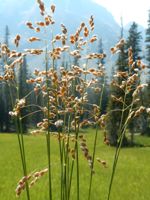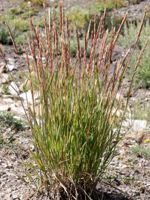Mon-Fri 9am - 5pm Mountain time
Sweetgrass vs Slender Wheatgrass
Anthoxanthum hirtum/Anthoxanthum nitens (Hierochloe odorata))
Elymus trachycaulus
CUSTOM GROW
CUSTOM GROW
Sweetgrass is a cool-season perennial grass best known for its sweet, vanilla-like fragrance. The scent comes from coumarin in the leaves, which is pleasant to humans but has a bitter taste that makes the plant less appealing to deer and other herbivores. As a cool-season grass, Sweetgrass grows most vigorously in spring and fall, slowing or even going dormant during the heat of summer.
It spreads quickly through creeping rhizomes and can be difficult to remove once established, so it is best planted in areas where its spread will not cause problems. Due to its deep, vigorous root system and preference for moist soils, Sweetgrass is especially useful for erosion control, soil stabilization, riparian plantings, and naturalization projects.
Note: Sweetgrass was formerly classified under the scientific name Hierochloe odorata and its subspecies. The subspecies found in Canada are currently considered two distinct species: Anthoxanthum hirtum, which is native across Canada, and Anthoxanthum nitens, which is native to Eastern Canada. Because these two species are alike and share many overlapping common names, they are often considered as only one species.
Slender Wheatgrass is a native perennial bunchgrass common across North America. It establishes quickly, making it effective for site recovery.
It produces upright seed heads that provide seasonal interest and seed for wildlife, and favoured for browsing by elk and sheep. Its seeds are eaten by birds and small mammals, and it provides cover for wildlife.
Slender Wheatgrass is among the first native grasses used for reclamation in western Canada and the U.S. It does exceptionally well in saline soils.
Sweetgrass Quick Facts
Slender Wheatgrass Quick Facts
Toxicity: toxic if large amounts ingested

